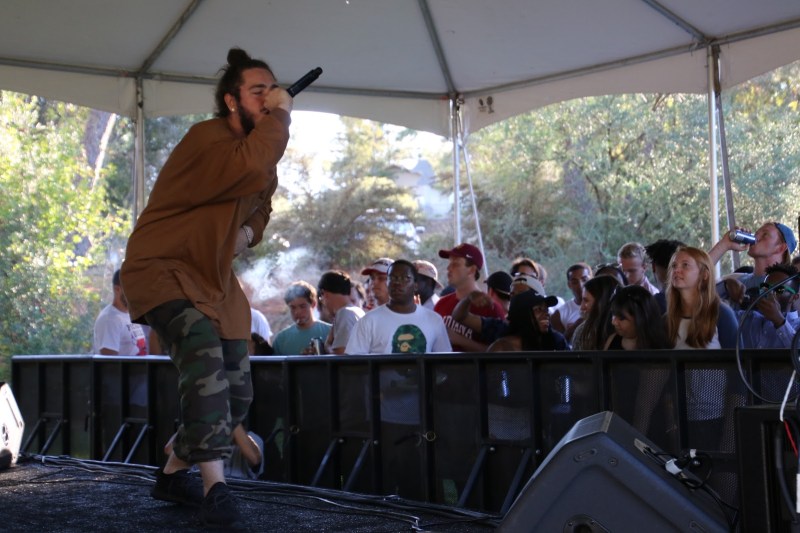This Saturday, Stanford Concert Network brought singer Bosco, producing duo FKi and the rising star Post Malone to campus for Fallout, a free concert on Levin Field (the one by FloMo).

Bosco opened with a set of electro-pop originals and remixes, regularly climbing off stage to interact directly with the crowd. Props to her for giving an energetic performance, despite the fact that she got off a red-eye flight from Atlanta to play a show for only 30 people. Further proof that you can bring Stanford students free concerts, but you can’t make them listen.
The crowd for Post Malone and his DJs, 1st and SauceLord Rich of FKi, was a bit better, and after opening with his big singles “White Iverson” and “Too Young,” Malone played the rest of his brief discography, including “Tear$,” “What’s Up” and rather appropriately, “That’s It.” He closed with an encore rendition of “White Iverson,” putting the cherry on top of an entertaining six-song set.
The brevity of Malone’s performance isn’t too surprising if you’re at all familiar with his background. Long story short, he made his breakout hit “White Iverson” on a whim, and that song’s viral success has carried him to bigger and better things (including a feature on Kanye’s mysterious upcoming album, “Swish”). With only five songs to his name, it seems like the music is just trying to keep up with the fame.
In the wake of Malone’s viral success, fans and skeptics alike have started digging into his past, and the plunder hasn’t been too promising for the rapper’s young career. First, we have a seven-second Vine posted in 2013, in which Malone, facing the camera and watching “Animal Planet,” drops the N-word in a lame attempt at humor. After this skeleton was dragged out of the closet, Malone issued a standard, ignorance-pleading apology. This type of immature behavior is almost routine for popular white rappers today, and it can’t be dismissed. At least it’s a sign of maturity on Malone’s part that he didn’t even try to defend his actions. But what else was hiding in his closet?
Well, in a strange twist, Malone is actually a wonderfully talented folk singer, although you wouldn’t know it after seeing him live. His fingerpicking cover of Bob Dylan’s “Don’t Think Twice, It’s All Right,” to which he injects a distinctly Southern twang, is actually beautiful. Posted on YouTube two years ago under his government name, Austin Post, this little piece of Americana adds a complex layer to his musical past and further obscures our understanding of his artistic development.
What can we make of Malone’s wildly successful artistic about-face? For one, it forces us to question his authenticity (as if we hadn’t already). Correct me if I’m wrong, but it’s unprecedented for a country boy from Dallas to go from bluegrass-inspired folk covers to a Kanye co-sign in the span of two years. From the looks of it, he jumped ship on the whole “white folk singer from Texas” path pretty quickly, instead searching for a genre where he’d have a better chance at standing out and launching a career — maybe by calling himself something crazy and attention-grabbing, like “White Iverson.”
His rapid ascent also forces us to again consider the controversies surrounding whiteness in hip-hop. As black music gains more and more cultural (read: white) acceptance, it becomes more and more commercialized. When Azealia Banks called out Iggy Azalea for the dual offense of 1) sounding no better than most other female rappers and 2) being white and successful while doing it, she seems to have accurately identified the music industry’s pernicious line of thinking: Who better to sell black music to white people than white artists? This is the catch-22 of hip-hop today and of rock-and-roll 60 years ago: The bigger it gets, the whiter it becomes.
Post Malone is a talented singer with more hit-making potential and a bright future ahead of him, and he seems to be a thoughtful guy, too. To his credit, he prefaced the mortality-obsessed “Too Young” with a respectful shoutout to Christian Taylor, a young black college athlete who was shot down by a white police officer in Malone’s home state of Texas in August, alongside nods to the late Moses Malone, former NBA MVP and Post’s presumed namesake, and A$AP Yams, an artistic influence who died of overdose earlier this year. And with that simple acknowledgement, he’s already doing much more than white hip-hop contemporaries like Iggy Azalea and Miley Cyrus.
But even with thoughtful artists (which Malone will hopefully become), the essence of white hip-hop’s popularity is still problematic. By becoming whiter, hip-hop is necessarily losing its blackness. By losing its blackness, hip-hop is losing its power to be a mainstream voice for black America. This isn’t to say that white artists have no place in hip-hop. I believe that with an affirmative respect for hip-hop and its roots, non-black artists can contribute meaningfully to the culture. But without an active engagement with the realities of hip-hop — of blackness — it’s simply too easy for white artists to assume an exploitative role, regardless of intention.
So for now, however catchy his songs are, I have a hard time rooting for Malone, simply because I’ll always be wondering: Whoever asked for a White Iverson in the first place?
You can contact Benjamin Sorensen at bcsoren ‘at’ stanford.edu.
